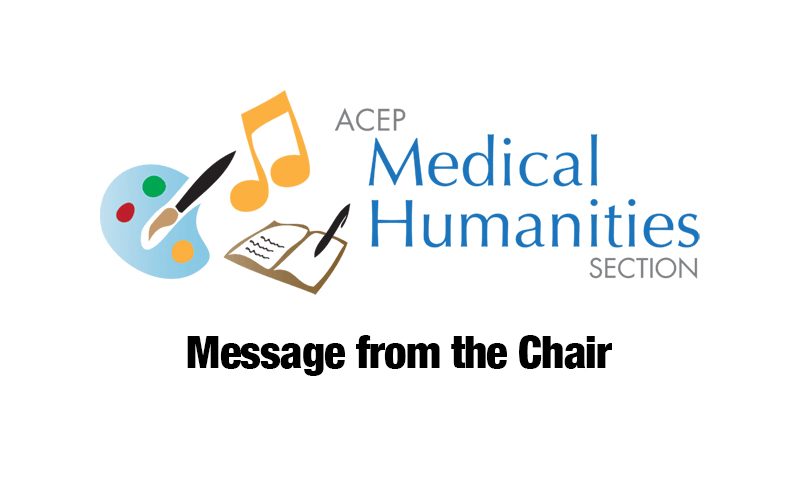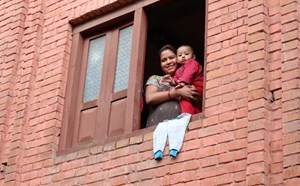
From the Chair
From the Chair
Kamna Balhara, MD, MA, FACEP
I hope you are all feeling inspired and invigorated after ACEP25 – especially after our engaging and exciting section meeting. There were many moments of connection and dialogue – such moments remind us of why we do this job and they create avenues for us to truly see each other as human beings. These moments are needed now more than ever. For those unable to attend this year, we missed you! We look forward to sustaining these important dialogues at MedHums Mondays and on the ACEP engagED platform.
I, like many, was fascinated (and slightly starstruck) by the inclusion of the actor Noah Wyle and the advisors of the TV show, “The Pitt,” in the ACEP25 plenary. The first season of the show, initially conceived as a revival of the 1990s television phenomenon “E.R.,” focuses on a single shift at a busy emergency department in the post-pandemic era. I have personally found the show challenging to watch, primarily because it feels like work. Honestly, I’ve probably seen two or three episodes at most.
Despite my own deep discomfort in watching the show, though, there is some undeniable magic in seeing elements of our daily lives rendered on the screen. It’s peculiarly rewarding to feel that little tug of recognition when the actors portray the good-natured camaraderie between colleagues or the deep rapid rapport we often develop with patients and families. It is also powerful to watch how the show portrays moments that are emotionally challenging, cognitively burdensome, or morally injurious – especially the kinds of moments that are difficult for us to translate to those around us. These are the moments that we might struggle to describe out loud to loved ones who don’t share our lived experiences as emergency physicians. My own husband is a physician, but his practice as an ophthalmologist is far removed from ours; sometimes, after enduring a particularly difficult day at work, I really have to push past my initial assumption of “he won’t understand” to make myself share what happened. The widespread interest of the public in “The Pitt” speaks to the fascination that our career holds for many across the country (and speaks a little to our society’s somewhat prurient interest in the suffering of others – “tell me about the grossest thing you’ve seen in the ED!” - that’s a question I dread). But it also creates hope in me that maybe they will understand. Is it really like this? they might ask. Yes it is, we can say. Their curiosity paves the way for dialogue.
Fiction can tell stories that we can’t or won’t tell. Certainly, the accuracy of such depictions can always be questioned (and I really hope that no one’s shift has such an extensive litany of calamities occurring in the span of a few hours). But it sparks hope – the hope that perhaps bearing witness to these stories will allow the broader public and society at large to better understand our struggles, and that this overwhelming public interest in the show may be leveraged to push for institutional policies or wider legislation that makes our patients’ lives better.
Perhaps this is all wishful thinking. I deeply hope that it’s not.
I do believe, regardless, that the audience engaging with these kinds of stories has a chance to truly “see” us – and that, too, is powerful on its own. It’s a testament to the extraordinary power and potential of fiction in helping tell challenging or provocative truths – so that truths can be seen, named, and discussed. So that we can be seen. Whether one likes the show or not, whether one even thinks it’s any good at all, is somewhat irrelevant – the point is that stories are important. This is why the work of this Section is so crucial, and why the arts and humanities are integral to our practice as emergency physicians. Stories can be cathartic, but they can also be catalytic – and the arts and humanities create space for stories to be told, whether visually or verbally. As a section, in sharing our work with each other, we bear witness to those stories.
I am full of optimism that we can sustain this momentum. I’m thrilled to share that the section has made significant progress on the consensus paper on the relevance of the health humanities to emergency medicine. Once published, it is our hope that the paper will function as a means of validation and support for those already engaged in the arts and humanities, and that it will serve as a beacon for those who have not yet had a chance to do so.
Let’s dedicate this coming year to being seen. I look forward to working with our wonderful section councillor on drafting a resolution for ACEP to publicly affirm the importance of the arts and humanities in emergency medicine. I also hope that many of us will submit courses or didactics to ACEP that showcase the power of the arts and humanities. Other projects include continuing to build our online repository of section members’ work and expertise, in order to support networking, collaborative projects, and potential speaking opportunities. At the section meeting, we also discussed launching an online platform where any ACEP member can submit arts- and humanities-based work – in any medium – for others to explore and view.
Most of all, I hope I keep hearing more people ask, “Is that really what it’s like? Is that really what you do?”
Yes, it is, and I’m proud to do it alongside each of you.



